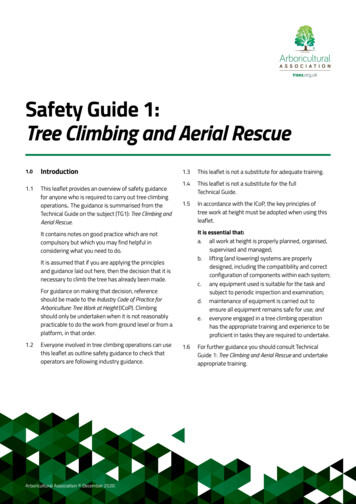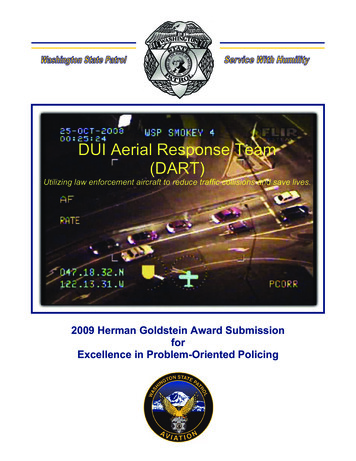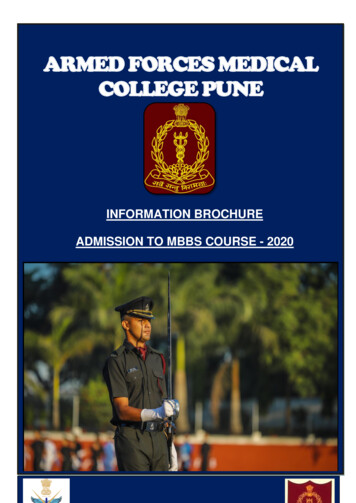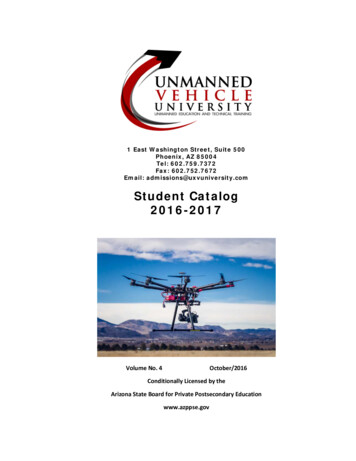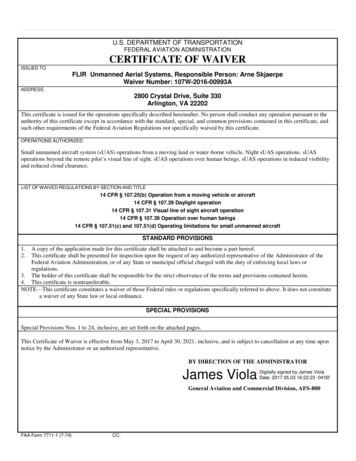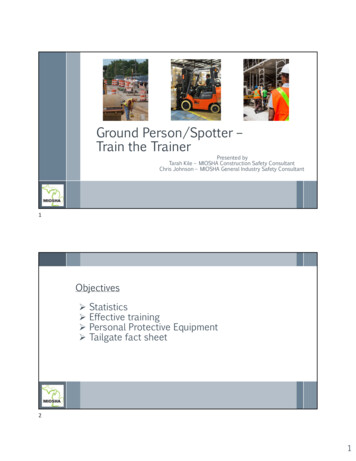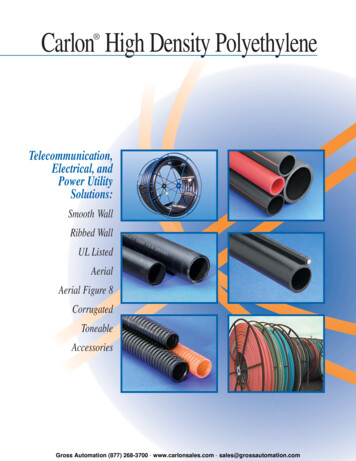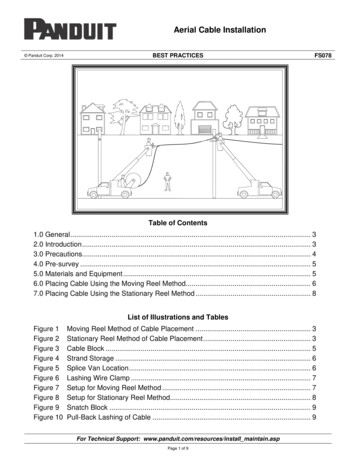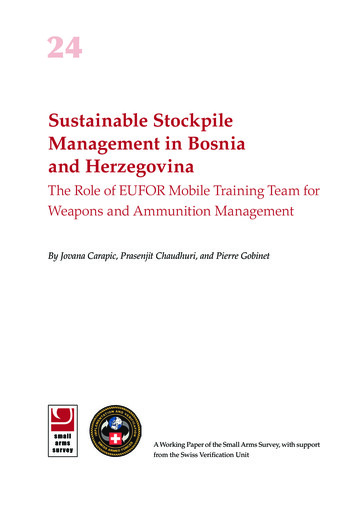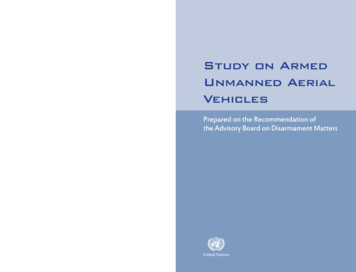
Transcription
Study on ArmedUnmanned AerialVehiclesPrepared on the Recommendation ofthe Advisory Board on Disarmament Matters
Study on Armed Unmanned Aerial VehiclesPrepared on the Recommendationof the Advisory Board on Disarmament Matters
NoteThe United Nations Office for Disarmament Affairs is publishing this materialwithin the context of General Assembly resolution 69/71 on the United NationsDisarmament Information Programme in order to further an informed debate on topicalissues of arms limitation, disarmament and security.The views expressed in this publication do not necessarily reflect those of theUnited Nations.Symbols of United Nations documents are composed of capital letters combinedwith figures. These documents are available in the official languages of the UnitedNations at http://ods.un.org. Specific disarmament-related documents can alsobe accessed through the disarmament reference collection at ml.This publication is available fromwww.un.org/disarmamentUNITED NATIONS PUBLICATIONCopyright United Nations, 2015All rights reservedPrinted in New York
ContentsForeword. . . . . . . . . . . . . . . . . . . . . . . . . . . . . . . . . . . . . . . . . . . . . . . vSummary. . . . . . . . . . . . . . . . . . . . . . . . . . . . . . . . . . . . . . . . . . . . . . . viiIntroduction. . . . . . . . . . . . . . . . . . . . . . . . . . . . . . . . . . . . . . . . . . . . . 1Chapter IDistinctions between civilian and military unmanned aerialvehicles. . . . . . . . . . . . . . . . . . . . . . . . . . . . . . . . . . . . . . . . . . . . . . . . 3I.Classification and functions. . . . . . . . . . . . . . . . . . . . . . . . . . . . . 5II.Multilaterally developed definitions and other means ofclassification. . . . . . . . . . . . . . . . . . . . . . . . . . . . . . . . . . . . . . . . 8United Nations Register of Conventional Arms. . . . . . . . . . . . . . 9Security Council resolution 1540 (2004). . . . . . . . . . . . . . . . . . 10Missile Technology Control Regime . . . . . . . . . . . . . . . . . . . . . 10Wassenaar Arrangement. . . . . . . . . . . . . . . . . . . . . . . . . . . . . . 11III. Distinguishing characteristics and technological trends . . . . . . 12Physical characteristics . . . . . . . . . . . . . . . . . . . . . . . . . . . . . . 12Command and control. . . . . . . . . . . . . . . . . . . . . . . . . . . . . . . . 13Loitering munitions. . . . . . . . . . . . . . . . . . . . . . . . . . . . . . . . . . 14IV.Conclusions. . . . . . . . . . . . . . . . . . . . . . . . . . . . . . . . . . . . . . . . 15Chapter IIInternational law applicable to the use of armed unmannedaerial vehicles outside areas of “traditional battlefields” . . . . . . . . 17I.Jus ad bellum . . . . . . . . . . . . . . . . . . . . . . . . . . . . . . . . . . . . . . . 17The prohibition of the use of force. . . . . . . . . . . . . . . . . . . . . . . . 17United Nations Security Council measures. . . . . . . . . . . . . . . . . 20Self-defence. . . . . . . . . . . . . . . . . . . . . . . . . . . . . . . . . . . . . . . . 20II.Use of force under international human rights andhumanitarian law. . . . . . . . . . . . . . . . . . . . . . . . . . . . . . . . . . . . 26iii
Targeting under international human rights law. . . . . . . . . . . . 26Targeting under international humanitarian law. . . . . . . . . . . . 30III. Conclusion . . . . . . . . . . . . . . . . . . . . . . . . . . . . . . . . . . . . . . . . 37Chapter IIIImplications of unmanned aerial vehicles and related emergingtechnologies . . . . . . . . . . . . . . . . . . . . . . . . . . . . . . . . . . . . . . . . . . . . 39I.Altering incentives in the use of force. . . . . . . . . . . . . . . . . . . . . 40II.Tempting States to interpret legal frameworks to permit fullerexploitation of the expanded capabilities of armed UAVs. . . . . 42III. Use of armed drones by covert armed forces in ways thatdo not permit sufficient transparency or accountability. . . . . . . 44IV.Increasing use by non-State armed groups or evenindividuals. . . . . . . . . . . . . . . . . . . . . . . . . . . . . . . . . . . . . . . . . 45V.Automation and compressing the “time to strike” process. . . . . 47VI. Conclusions. . . . . . . . . . . . . . . . . . . . . . . . . . . . . . . . . . . . . . . . 48Chapter IVTransparency, oversight and accountability for the use of armedunmanned aerial vehicles outside areas of active hostilities. . . . . . 49I.Motivations for seeking transparency, oversight andaccountability mechanisms. . . . . . . . . . . . . . . . . . . . . . . . . . . . . 50II.Transparency and accountability in targeted strikes usingarmed UAVs outside areas of active hostilities. . . . . . . . . . . . . . 52Requirements under international law . . . . . . . . . . . . . . . . . . . . 52Mechanisms for increasing transparency in targetedstrikes outside areas of active hostilities as a confidencebuilding measure. . . . . . . . . . . . . . . . . . . . . . . . . . . . . . . . . . . . 55III. Measures for increasing transparency, oversight andaccountability pertaining to the use of armed UAVs outsideareas of active hostilities. . . . . . . . . . . . . . . . . . . . . . . . . . . . . . 58Increasing transparency in the development, acquisition,stockpiling and transfer of armed UAVs . . . . . . . . . . . . . . . . . . 59IV.ivFurther elaboration of international mechanisms. . . . . . . . . . . . 61
ForewordUnited Nations and other multilateral disarmament bodieshave been seized for some time of the concern that unmanned aerialvehicles (UAVs) might be used as a means to deliver weapons of massdestruction. However, in recent years, there has been growing interestwithin the international community to address issues posed by theincreasing use of UAVs to conduct targeted strikes, especially in areasoutside active hostilities.United Nations disarmament bodies are well suited to considerthese matters, as they have long been concerned with the regulationof technologies that challenge humanitarian principles or whosewidespread proliferation and use raise implications for internationalpeace and security. I therefore welcomed the recommendation bythe Secretary-General’s Advisory Board on Disarmament Matters tocommission a study on UAVs.The Secretary-General’s position on armed UAVs has been clear:they must only be used in accordance with international humanitarianlaw and international human rights law. It remains imperative for theinternational community to reach consensus on the interpretation ofestablished international principles and their application to the use ofarmed UAVs.At the same time, it must be acknowledged that UAVs haveunique characteristics that make them particularly susceptible tomisuse in comparison to other technologies. These include their lowcosts, which can aid their rapid proliferation; their small size andprecision, which can tempt covert armed forces and non-State actorsto use them secretly and without appropriate transparency, oversightand accountability; and the minimal risk to their operators, which canlower political thresholds for the use of force.I support increasing transparency, oversight and accountabilityin the development, acquisition, stockpiling, transfer and use of armedUAVs as a confidence-building measure. This study surveys a numberof possible ways in which this can be accomplished. I also support thepursuit of further research on the implications to international peace,v
Study on Armed Unmanned Aerial Vehiclessecurity and stability posed by armed UAVs as well as on their impacton civilians.I hope this study serves as a point of departure for furthermultilateral engagement on these matters.I commend this study to all States for their attention.Kim Won-sooUnder-Secretary-GeneralActing High Representative for Disarmament AffairsSeptember 2015vi
SummaryThis study has been prepared by the United Nations Office forDisarmament Affairs pursuant to the recommendation of the SecretaryGeneral’s Advisory Board on Disarmament Matters (A/69/208) withassistance by the United Nations Institute for Disarmament Researchand the Human Rights Institute at the Columbia University School ofLaw.Unmanned aerial vehicles (UAVs) for civil and military use,including those used to conduct armed strikes, can be distinguishedand categorized based on physical characteristics such as maximumtake-off weight, range, payload, endurance and means of commandand control. Civil demand remains limited generally to small UAVswith a maximum take-off weight of less than 150 kg. Armed forcesoperate UAVs of all weight classes. Most armed UAVs are largesystems with a maximum take-off weight in excess of 600 kg. Thereare examples, however, of armed medium-weight UAVs capableof carrying existing types of air-to-surface rockets. Furthermore,smaller systems are capable of employing weapons, either by designor adaptation, and being flown beyond the visual line-of-sight of theoperator. A further relevant advent is the increasing development,production and export of remotely piloted loitering munitions orcruise missiles. Accordingly, thresholds found in existing multilateralexport control regimes, which were once sufficient to act as a brake onthe widespread proliferation of all types of armed UAVs, not just thosecapable of delivering weapons of mass destruction, have become lesseffective in regulating the spread of armed UAVs per se.In the context of lethal targeting, the law governing the rightto resort to force against another State must be distinguished fromthe law governing the use of force against individuals. These legalframeworks apply in parallel.The United Nations Charter prohibits the “threat or use offorce against the territorial integrity or political independence of anystate”. Where a State has not given its consent to the use of forceon its territory, there are two exceptions to the prohibition: SecurityCouncil action pursuant to Chapter VII or in a State’s self-defence.Self-defence arises when an armed attack against a State requires avii
Study on Armed Unmanned Aerial Vehiclesforcible response to remove the grave and persisting danger that theattack poses. Any resort to force in self-defence must comply withthe conditions of necessity and proportionality, and any force used toprevent an “imminent” attack must be in response to an attack that isinstant, overwhelming, and leaving no choice of means.Under international human rights law, the taking of life isonly lawful where strictly necessary to protect against an imminentthreat to life. Any use of force must meet the principles of necessity,proportionality and precaution. International humanitarian law,which applies only in armed conflict, requires that parties distinguishbetween civilian persons and civilian objects on the one hand, andcombatants and military objectives on the other, and that they directtheir operations only against combatants and military objectives.Civilians are entitled to protection against direct attack unless andfor such time as they directly participate in hostilities. While civilianpersons and objects may be incidentally harmed in an attack, the ruleof proportionality dictates that “incidental loss” of civilian life orproperty must not be excessive in relation to the concrete and directmilitary advantage anticipated from an attack against a militaryobjective. Parties to an armed conflict must also take “feasible”precautions in carrying out attacks in order to avoid and minimizeincidental loss of civilian life, injury to civilians and damage tocivilian objects.While the use of armed UAVs may offer a number of advantages,including enhancing the potential to comply with international law,they have also elicited some unease about a weakening of the standardfor deploying force and raised new challenges in the applicationand interpretation of international law. States’ lack of transparencyon their operations, the applicable legal frameworks or their criteriafor selecting targets adds to the concern. A strict application andprotective interpretation of the relevant legal frameworks mayalleviate some common concerns about their use in lethal targeting,but this can only be complementary to the important ethical, moraland political debates that must accompany the development and use ofsuch weapon systems.Due to their unique characteristics, armed UAVs raise particularimplications for the maintenance of international peace, security andviii
Summarystability, as well as the integrity of international humanitarian andhuman rights principles. They can alter incentives for the use of forceby lowering the risk to one’s own armed forces and civilian populationor by enabling new types of low-intensity conflict. Their capabilitiesenable armed forces to pursue new types of missions, tempting Statesto interpret international humanitarian and human rights law in waysthat permit expanded use of force. They are attractive to covert armedforces that operate in ways that may not permit sufficient transparencyand accountability. They could become increasingly available tonon-State actors, providing them with inexpensive options to conductattacks with increasing control and precision. They can drive thedevelopment of increasing autonomy in weapon systems, reducingdecision times for strikes and thereby diminishing human controlover the use of force. It should also be acknowledged that in somecircumstances, the use of armed UAVs can facilitate greater adherenceto humanitarian principles.States and civil society seek increased transparency, oversightand accountability for the use of armed UAVs outside areas of activehostilities for various reasons, including to increase confidence inadherence to international law; reduce the potential for unlawfulacts through the promotion of norms and common standards forbehaviour; protect civilians; promote international peace and security;promote the democratic legitimacy of counter-terrorism operations;assist in the investigation of human rights violations; and facilitateimplementation of export controls.International human rights law requires an investigationwhenever death, serious injury or other grave consequences resultfrom the use of force. Accountability depends on public access to therelevant information and victims have a right to access informationrelating to allegations of violations and their investigation. Statesalso have a duty to investigate serious international humanitarian lawviolations over which they have jurisdiction. If appropriate, Statesmust prosecute the suspects. Investigations should strive to meetstandards of independence, impartiality, effectiveness, promptness,thoroughness and transparency.The development of transparency and confidence-buildingmeasures can be effective in addressing issues posed by armedix
Study on Armed Unmanned Aerial VehiclesUAVs. The implementation of mechanisms to increase transparency,oversight and accountability can be pursued through unilateral,bilateral, plurilateral or multilateral measures and can includedisclosure of information to various recipients including the public.The protection of sensitive operational information and intelligencesources is an important consideration in this regard. While thereremains an urgent need for States to establish common definitionsand interpretations of key legal principles, it remains possible todevelop effective transparency and confidence-building measures andto increase accountability and oversight even in the absence of suchshared understanding.Possible information that States could provide with respect tothe use of UAVs to conduct targeted strikes outside areas of activehostilities include the following: information regarding the legalframework, national laws and policies that a State applies to specificsituations in which an armed unmanned aerial vehicle may be used;information regarding processes for accountability and investigationsinto allegations of violations to the right to life and credibleallegations of war crimes; information regarding the legal basis foreach use of force; operational information on each targeted strike,including its location, the targeting criteria, the weapon system usedand on civilian casualties; and the results of investigations or factfinding assessments.A mechanism for increasing transparency and confidencebuilding on armed UAVs could also provide for the sharing ofinformation related to the development, acquisition, stockpiling andtransfer of armed UAVs, building upon existing international legalobligations and voluntary United Nations mechanisms. Possiblemeasures include the following: publication of national reviews underarticle 36 of Additional Protocol I to the 1949 Geneva Conventions;provision of data on imports, exports and holdings to the UnitedNations Register of Conventional Arms and publication of annualreports pursuant to article 13 (3) of the Arms Trade Treaty, if suchinformation has not been submitted to the United Nations Register;agreed procedures to enable States to cooperate in order to prevent,investigate or mitigate any diversion of armed UAVs, in accordancewith article 11 of the Arms Trade Treaty; and establishment ofcommon requirements for end-user certificates that could be appliedx
Summaryto any exports of armed UAVs providing assurances on the use of thesystem.The widespread acceptance of transparency and confidencebuilding measures on armed UAVs would benefit from theirdevelopment within a multilateral framework, and with meaningfulengagement by civil society. In the near-term, multilateral engagementon this matter could be best facilitated through a study conductedunder the auspices of the United Nations Institute for DisarmamentResearch with the assistance of a geographically representative groupof qualified experts.xi
Introduction1. From its fifty-ninth to sixty-second sessions (2013-2014),the Secretary-General’s Advisory Board on Disarmament Mattersdiscussed the issue of unmanned aerial vehicles (UAVs) as part of itsconsideration of its agenda item entitled “Disarmament and securityimplications of emerging technologies”.1 In 2014, at the end of sixtyfirst and sixty-second sessions, the Advisory Board recommendedwith respect to UAVs that:The Secretary-General should commission a studyto examine the distinction between armed/militarydrones and unarmed/peaceful/civilian drones, and suchideas as improving transparency in targeted unmannedaerial vehicle strikes as a confidence-building measureand developing a robust oversight and accountabilitymechanisms for targeted strikes outside active battlefields.The proposed study should also consider internationalhumanitarian law and how relevant principles such asdistinction, proportionality and military necessity shouldbe applied, with a view to avoiding excessive injurious orindiscriminate effects.The Secretary-General should consider including in theabove-mentioned study a broader range of emergingtechnologies that might have an impact on internationalsecurity and the arms control process, including in the fieldof outer space.2. As announced by the Chair of the Advisory Board, IstvánGyarmati (Hungary), at the 9th meeting of the sixth-ninth sessionof the Disarmament and International Security Committee (FirstCommittee) of the General Assembly, the Secretary-General agreedwith the recommendation and commissioned the United NationsOffice for Disarmament Affairs (UNODA) to produce the study. Thepresent study has been prepared within existing resources and withresearch and analysis by the United Nations Institute for Disarmament1See the reports of the Secretary-General on the work of the Advisory Board onDisarmament Matters (A/68/206 and A/69/208).1
Study on Armed Unmanned Aerial VehiclesResearch and the Human Rights Institute at the Columbia UniversitySchool of Law, which served as consultants.3. To facilitate the development of the aspects of the study thataddress improving transparency, oversight and accountability inthe use of UAVs to conduct targeted strikes outside areas of activehostilities, UNODA and the United Nations Institute for DisarmamentResearch co-organized an “International seminar on improvingtransparency, oversight and accountability for any use of armedunmanned aerial vehicles outside areas of active hostilities”, held inGeneva on 15 and 16 June 2015. The seminar was made possible bythe financial support provided by Germany, Switzerland and the OpenSociety Foundations.4. UNODA expresses its gratitude to the individuals who providedcontributions and research to the study, John Borrie, Amy Dowler,Sarah Knuckey, Michael Spies and Nathalie Weizmann. Sincereappreciation also goes to the individuals who provided researchassistance for the preparation of the study, Elena Finckh and SanneVerschuren, as well as to those who provided invaluable commentsand support, Chris King and Kerstin Vignard.2
Chapter IDistinctions between civilian and militaryunmanned aerial vehicles1. The increasing development and acquisition of armed unmannedaerial vehicles (UAVs), and the widely documented impact thattheir use has had on civilian populations,1 has driven greaterinterest in understanding the implications posed by this technologyfor international peace and security, as well as for humanitarianand human rights concerns. This has resulted in new demands fordeveloping mechanisms to increase transparency and accountabilitywith respect to their proliferation and use. As a foundation for thediscussion in subsequent chapters on substantive issues relating toarmed UAVs, this chapter examines the distinctions between unarmedmilitary, armed military and civil UAVs.2. In this study, the term “unmanned aerial vehicle” is synonymouswith “unmanned aircraft”, and can be defined as an aircraft that isintended to operate with no pilot on board.2 The term “unmannedaerial system” refers to a UAV and its associated support and logisticalelements. The term “remotely piloted aircraft” refers to the subset ofUAVs that are controlled by a pilot who is not on board the vehicle,in contrast to an “autonomous aircraft”, which refers to unmannedaircraft that do not allow pilot intervention in the management of itsflight. It should be noted, however, that a number of remotely piloted12See, e.g., Columbia Law School Human Rights Clinic and the Center for Civiliansin Conflict, “The Civilian Impact of Drones: Unexamined Costs, UnansweredQuestions”, 2012 an%20Impact%20of%20Drones.pdf);AmritSingh, “Death by Drone: Civilian Harm Caused by U.S. Targeted Killings in Yemen”,Open Society Foundations, April 2015 lt/files/death-drones-report-eng-20150413.pdf); and Open SocietyFoundations, “After the Dead Are Counted: U.S. and Pakistani Responsibilities toVictims of Drone Strikes”, November 2014 e are no formal and internationally recognized definitions for the termsdiscussed in this paragraph. General reference is made to the 2011 informationcircular by the International Civil Aviation Organization, Cir 328-AN/190, onUnmanned Aircraft Systems (UAS), which includes an informal glossary of terms.3
Study on Armed Unmanned Aerial Vehiclesaircraft can fly autonomously without pilot intervention for managingportions of their flight. While this study uses the more general termUAV, it is concerned exclusively with remotely piloted aircraft.Although remotely piloted and autonomous aircraft may pose manysimilar challenges, the latter are not taken up in this study because thematter of autonomous weapon systems3 is a distinct issue that meritsseparate consideration.3. There are a number of reasons why UAVs should be addressedas a distinct category of weapon system for the purpose of armscontrol. As elaborated below and in subsequent chapters, UAVs havea number of unique characteristics that give them greater potentialto be misused. These characteristics—such as, inter alia, their lowcost, relatively small size and portability, as well as the perceptionsof reduced risk of harm to operators, potentially lowering politicalrisks associated with decisions to use force while simultaneouslyexpanding the geographical scope of armed conflicts—include factorsthat make these systems more attractive to covert special forces,intelligence agencies and non-State actors than manned combataircraft. Taken together, these factors mean that armed UAVs not onlypose challenges to ensuring that States and armed groups complywith international law, but also raise unique implications for themaintenance of international peace and security.4. In light of the inherent dual-use nature of UAVs, whichhave numerous civil, commercial and military applications, thedevelopment of reliable means of distinguishing between variousclasses of UAVs and their functions is essential for meaningfularms control.4 The absence of any internationally agreed system forclassifying UAVs further complicates this task, although in practicevarious national classification systems overlap to a degree sufficientto describe the relationship between various classes of UAVs and theirmilitary or civil functions.344This can be defined as a weapon system in which a human does not operate thecritical functions of selecting and attacking a target.Analysis in this section draws upon data obtained from open sources on a nonexhaustive list of more than 550 types and variants of civil and military UAVsin operation or under development in more than 50 States.
Distinctions between civilian and military unmanned aerial vehicles5. Definitions in multilaterally developed export control listsand guidelines are of decreasing relevance in serving as a basis fordistinguishing between military and civilian UAVs, due in particularto advances in technology. Many basic characteristics of UAVs usedin these guidelines and lists, such as weight, range, payload andendurance, are becoming less relevant, as militaries now operateUAVs across a wide spectrum of these characteristics and ever smallersystems are capable of employing weapons, including beyond thevisual line-of-sight of the operator. These trends point to the needfor continued innovation in arms control approaches, which haveincreasingly fallen behind the development of UAVs and relatedtechnologies.I.Classification and functions6. Governments and international organizations make use of varioussystems for classifying and categorizing UAVs. These classificationsare generally based on a number of basic characteristics, particularlyweight, endurance and operating range. Various categories of UAVsalso correlate generally with other characteristics, such as normal/maximum operating altitude, command and control capability, wingtype and typical uses or functions. The great diversity in the typesand capabilities of all types of UAVs works against the establishmentof all-encompassing classification systems.5 Civilian and militaryauthorities tend to structure their classification of drones based onmaximum gross take-off weight and typical/maximum cruisingaltitude. While many national classification systems employ similarterms and basic approaches, definitions and the delineations betweencategories can vary.7. Small UAVs are typically defined as systems with a maximumtake-off weight of up to 150 kg. They are normally flown withinthe visual line-of-sight6 of the operator up to a maximum altitude of56Consider the United Kingdom Ministry of Defence Joint Doctrine Note 2/11, “TheUK Approach to Unmanned Aircraft Systems”, 30 March 2011, which describes asmall (30 kg) UAV capable of transatlantic flight. Available from ds/attachment data/file/33711/20110505JDN 211UAS v2U.pdf.Commonly abbreviated as VLOS.5
Study on Armed Unmanned Aerial Vehicles500 feet above the ground. The development of UAVs of this weightclass are experiencing the fastest commercial growth because of theirlow cost, ease of use and less complicated integration into nationalairspace. There is already an active market for civil/small UAVs forvisual line-of-sight operations, although there is growing demand andinterest in more advanced small UAVs capable of operating beyondvisual line-of-sight,7 including for the purpose of routine commercialcargo and delivery flights. Although cut-off weights vary betweennational classification systems, small UAVs can be subcategorized asfollows:a.Miniature UAVs are smaller than 10 kg and generallycan be launched manually by a human. Some classification systemsconsider “mini” to extend up to 20 kg, a size at which catapults orsome other form of assistance, such as rockets, a launch tube or useof a runway, become necessary for the launch of fixed-wing systems.Most UAVs used by militaries in target acquisition roles are smallsystems that fall within this subcategory and can be hand-launched.b. Miniature systems, which, in military roles, can besophisticated enough to require a crew of two or more individualsto operate, are often further distinguished from “micro” UAVs,which are generally smaller than 2 kg and can be hand-launched andoperated by a single person. There are fewer examples of UAVs in thissmallest tier, although it includes models designed for military use inintelligence, surveillance and reconnaissance (ISR) roles as well asfor civil, commercial and recreational use.8. Medium UAVs are typically defined as systems with a maximumtake-off weight between 150 kg and 600 kg. Most systems in thisweight class are operated only by militaries, mainly for use in ISRroles. They are typically operated below 18,000 feet above sealevel, have a range of less than 800 km and an endurance of only afew hours. Payloads for these systems a
42 III. Use of armed drones by covert armed forces in ways that do not permit sufficient transparency or accountability.
